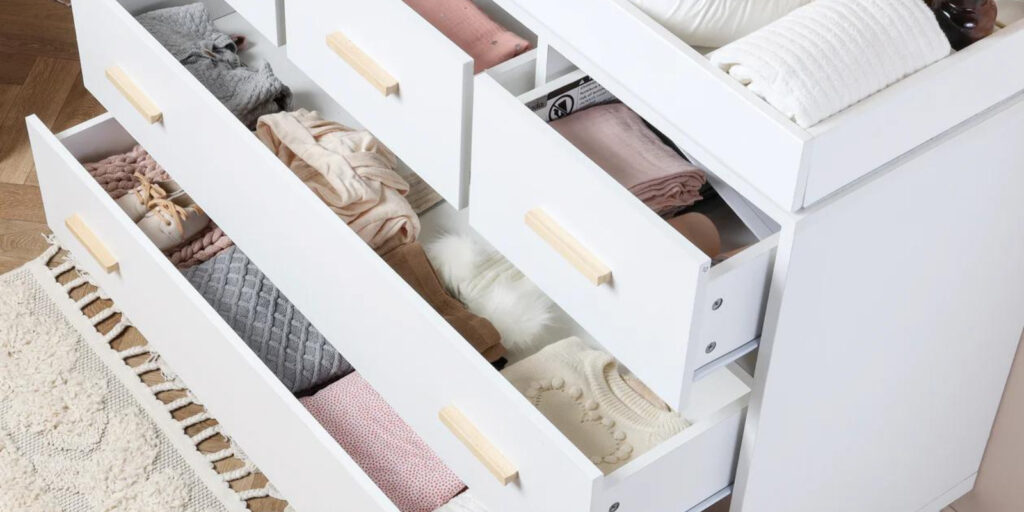Parent Hack: How to Organize Baby Clothes
Gazing at your baby’s wardrobe is an immediate mood boost—miniature jammies, tiny booties, itty bitty pants and tops? They’re a shot of serotonin to your brain. But it’s crazy how quickly newborn-sized clothing can take over your space. Before you’re overwhelmed by piles of baby clothes, take some time to get organized and stay on top of the mess.
Is organizing baby clothes our favorite nesting cardio? Definitely!
- Remove price tags + wash clothing before you put it away. Babies have super sensitive skin, so anything coming in contact with your baby’s skin (clothing, towels, sheets, etc.) should be laundered prior to being worn. Plus, it’s faster and more efficient to do one bulky load of laundry.
- Create your storage strategy. Consider your closet space and furniture pieces when deciding what to hang and what to fold and store in drawers. Bulky items like coats and sweatshirts, dresses, and anything that may need ironing should be hung to maximize space.
- Organize by category. Sort your baby clothes by type and group categories together. Knowing exactly where to find that onesie will save you time in the long run.
- Group by size. New parents, prepare to be blown away by how quickly your baby outgrows clothes. Organizing by size makes it easier to know that you’ve got every age and stage covered.
- Use baby hangers and closet dividers. Infant-sized hangers will prevent stretching out clothing and dividers make locating the size you’re looking for easy to spot. Give clothes in your baby’s current size the best closet real estate (the center of the closet rail).
- Consider adding a second closet rail. Double your closet space with very little effort or cost—a win-win in our book.
- Utilize the back of doors. There are so many storage system options that can be mounted to or hung from the back of doors, and they won’t take up any floor space.
- Assign dresser drawers to a clothing type. Outside of the top drawers—which we like to use for diapering essentials—use each drawer for one specific type of clothing, like onesies, pajamas, pants, etc. Your sleep-deprived brain will come to appreciate auto-dressing through muscle memory.
- Use drawer dividers or organizational bins. While grown-up clothes are bulky enough to remain neatly folded in drawers, baby items are not. Dividers or bins will keep clothing folded and easily accessible, and wrangle the really tiny items like socks or booties.
- Fold, stack, or roll? We’re talking about the backbone of your baby’s wardrobe: The onesie (or bodysuit). Folding and stacking plain white onesies works perfectly fine. But we’d suggest rolling onesies that have all-over patterns or are solid colors. Any onesie with a design on the front should be file-folded so you can easily find a particular item.
- Deal with dirty laundry. Keep it simple—a laundry basket at the bottom of the closet makes it easy to toss away dirty clothing and take it to the washroom.
- Designate spaces for out-of-use clothing. Use bins or baskets to separate too-small, too-big, ready-to-donate, and keep for hand-me-downs clothing items.
- Ready, steady, purge! When you notice that your baby’s clothes are getting a little snug, start pulling those sizes out of rotation. Purging as you go is a relatively quick job and will prevent the need for a total closet overhaul (no thank you very much).
- Don’t forget baby safety. Always remember that your newborn will one day be mobile, so make sure messy or unsafe baby products aren’t in bottom drawers or on low shelves.
Finding What’s Right for You
Albee Baby is the oldest family-owned specialty baby shop in the US, and we pride ourselves on providing our customers with the best assortment of baby products anywhere, at fair prices, always. We’re committed to being an inclusive resource for parents, and hope you’re feeling empowered to find the right baby gear for your family. Still have questions? Feel free to contact our baby gear experts at 877.692.5233 or by email at [email protected].

